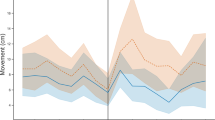Summary
Magnetic field (MF) bursts at a frequency of 250 Hz oriented parallel to the field-lines of the EMF induce unequivocal ‘jumps’ of misdirection of up to +10°. The regression of burst intensity (BI inγ; for a range of 10–1400γ) and the size of the induced jumps of misdirection (DMID in angular degrees) follow the equation: DMID= −1+ln BI. Compensation (<5% of the total intensity) of the EMF, continuous 250 Hz fields and bursts perpendicular to the static MF have no effect. The effects described are discussed from the point of view of magnetic resonance.
Similar content being viewed by others
Abbreviations
- BI :
-
burst intensity inγ
- DMID :
-
difference (jump) of misdirection in angular degrees
- EMF :
-
earth's magnetic field
- ΔF :
-
MF variation of the total component
- g :
-
stands forγ in figures
- H :
-
magnetic field force in Oersteds
- MF :
-
magnetic field
- NAT :
-
natural magnetic field in Tables (= EMF)
- Oe :
-
Oersted, unit of the magnetic field force
- γ :
-
10−5Oe
- g :
-
gyromagnetic ratio (a nuclear specific constant) in Hertz/Gauss
- μn :
-
nuclear magneton
- ω L :
-
Larmor frequency
References
Dwek RA (1973) Nuclear magnetic resonance (N.M.R.) in biochemistry. Clarendon Press, Oxford
Frisch K von (1965) Tanzsprache und Orientierung der Bienen. Springer, Berlin Heidelberg New York
Kilbert K (1979) Geräuschanalyse der Tanzlaute der Honigbiene (Apis mellifica) in unterschiedlichen magnetischen Feldsituationen. J Comp Physiol 132:11–25
Kirschvink JL (1981) The horizontal magnetic dance of the honeybee is compatible with a single-domain ferromagnetic magnetoreceptor. BioSystems 14:193–203
Kirschvink JL, Gould JL (1981) Biogenic magnetite as a basis for magnetic field detection in animals. BioSystems 13:181–201
Knowles PF, Marsh D, Rattle HWE (1976) Magnetic resonance of biomolecules. An introduction to the theory and practice of NMR and ESR in biological systems. John Wiley, London New York Sydney Toronto
Korall H, Martin H (1987) Responses of bristle field sensilla inApis mellifica to geomagnetic and astrophysical fields. J Comp Physiol A 161:1–22
Lindauer M (1976) Orientierung der Tiere. Verb Dtsch Zool Ges 1976:156–183
Lindauer M, Martin H (1968) Die Schwereorientierung der Bienen unter dem Einfluß des Erdmagnetfeldes. Z Vergl Physiol 60:219–243
Martin H, Lindauer M (1973) Orientierung im Erdmagnetfeld. Fortschr Zool 21(2/3):211–228
Martin H, Lindauer M (1977) Der Einfluß des Erdmagnetfeldes auf die Schwereorientierung der Honigbiene (Apis mellifica). J Comp Physiol 122:145–187
McLaughlin AC, Cullis PR, Hemminga M, Brown FF, Brocklehurst J (1977) Magnetic resonance studies of model and biological membranes. In: Dwek RA, Campbell ID, Richards RE, Williams RJP (eds) NMR in biology. Academic Press, London New York San Francisco, pp 231–246
Roth K, Gronenborn AM (1982) NMR Tomographie. Chemie in unserer Zeit 20(2):35–45
Schulten K, Windemuth A (1986) Model for a physiological magnetic compass. In: Maret G, Kiepenheuer J, Boccara N (eds) Biophysical effects of steady magnetic fields. Springer, Berlin Heidelberg New York, pp 99–106
Slichter CP (1964) Principles of magnetic resonance (with examples from solid state physics). Harper & Row, New York/Evanston and Weatherhill Inc, Tokyo
Author information
Authors and Affiliations
Additional information
Dedicated to Prof. Dr. Drs. h.c. H. Autrum on the occasion of his 80th birthday
Rights and permissions
About this article
Cite this article
Korall, H., Leucht, T. & Martin, H. Bursts of magnetic fields induce jumps of misdirection in bees by a mechanism of magnetic resonance. J. Comp. Physiol. 162, 279–284 (1988). https://doi.org/10.1007/BF00606116
Accepted:
Issue Date:
DOI: https://doi.org/10.1007/BF00606116




